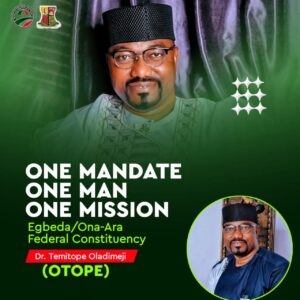CREATION of Ibadan was circumstantial…..

The history of Ibadan had long been preserved through oral history but written record says it was formed in 1829. After the collapse of the Yoruba Empire towards the end of the 18th century, ‘Eba Odan’ had been populated by Yoruba rebels. ‘Eba Odan’ means between the forests and the plains and it was surrounded by seven hills, it functioned as a sacred area for the fighters that fled the war. Before the existence of Ibadan, Oyo, a very powerful empire, was long established and govern larger part of Yoruba land, many fierce independent warriors emerged from Oyo such as Bashorun Gaa.
Bashorun Gaa was the head of the Oyo Mesi, He was a monster in the kingdom. While on the throne as prime minister between 1750 and 1774, Bashorun Gaa was a classical tyrant ruler. He instrumental the killing of four kings or forced them to commit suicide (Faleti,1972). Alaafin Labisi 1750 after 17 days on the throne; Alaafin Awonbioju 1750 after 130 days on the throne; Alaafin Agboluaye 1750-1772 (Agboluaje submitted to Bashorun Gaa’s dictation but was later forced to commit suicide under the command of Bashorun Gaa) and also executed Alaafin Majeogbe 1772-1773. He also instructed the murder of the daughter of Alaafin Abiodun and later used the victim for money ritual. Bashorun Gaa, unconstitutionally hijacked all the political power and machinery of Oyo kingdom.

The elimination of Bashorun Gaa was a difficult task. It cost the old Oyo kingdom lots of both human and natural resources. Alaafin Abiodun and Oyo warriors in collaboration with Aare-Ona-Kaka-N-fo Oyalabi, arrested Gaa. He was tied to a stake at Akesan market and Alaafin Abiodun ordered that every citizen should cut a pound of flesh from his body and drop it in a huge fire in front of him. He was made to smell the odour of his own flesh, his nose was not allowed to be cut. The remains of his body were later burnt in fire to prevent his re-incarnation.
ALSO READ: Check Fact: Brief History Of Ondo People
His embarrassing death led to the popular Yoruba saying that “Bi o ba la’ya O si’ka; bi’o ba ri’ku Gaa, O sooto” which means (if you are wicked and pigheaded when you see the death of Gaa, try to be good and speak the truth) Before 1829 Lagelu, the Jagun (commander-in-chief) of Ife and Yoruba’s generalissimo, left Ile Ife with some people from Ife, Oyo and Ijebu to found a new city, at Eba Odan, the first city was destroyed due to an incident at an Egungun (masquerade) festival when an Egungun was accidentally disrobed and mocked by women and children in an open marketplace. Meanwhile, In Yorubaland, it was an abomination for women to have eye-to-eye contact with Egungun, Egungun was considered to be the dead forefathers who returned to the earth each year to bless their descendant. When this news reached Sango, the then Alaafin of Oyo, he commanded that Eba-Odan be destroyed for committing such abominable act.
Lagelu and some of his people fled to a nearby hill for protection (sacred place). On the hill they survived by eating Oro fruit and Igbin (snails); later, they cultivated the land and made corn and millets into pap meals (eko), which they ate with roasted snails. They improvised a bit by using the snail shells (Ikarahun Igbin) to drink the liquefied eko. This eating habit formed part of the ancestral praise (Oriki) of Ibadan people today. Later, Lagelu and his people came down from the hill and founded another city called Eba’dan on the same spot.
ALSO READ: HISTORICAL: The Story Of ADEGBORO L’OJA OBA
They began to welcome more people to expand. Eba’dan became a refugee center. Various people, such as warriors, war escapee, escaped slaves, people in exile etc from various parts of other Yoruba cities. They developed more flexible laws because of the diverse nature of the people. Ibadan grew into an impressive and sprawling urban centre so much that by the end of 1829, Ibadan dominated the Yorùbá region militarily, politically and economically. Shortly, Lagelu died, leaving behind a politically oriented people and a very stable community. Around 1826/27, Afọnja of Ilorin, who was the Arẹ-Ọna-Kankan-Fo of old Ọyọ Empire, refused to carry out the order of Alaafin, when told to wage war against Iwere-Ile, a Yoruba town in Oyo.
An unresolved rivalry brewed between Alaafin and Afọnja. Afọnja formed alliance with Alimi, the head of Fulani warriors (who are settlers in Ilorin) against Ọyọ, and Oyo kingdom was destroyed. Unfortunately, Fulani supporters turned against Afonja as well and killed him on the order of Alimi. Ilọrin also lost its independence and became Fulani controlled territory. Therefore, whenever Yoruba says Ilorin is afonja’s city, Fulani will say ‘’it is Alimi’s city. This led to the present saying of ‘Ilorin afonja-Geri alimi’. In 1840, Fulani Caliphate began to raid towards Ibadan, Oyo indigenes begin to retreats towards Ibadan, a well developed Ibadan army confronted them and pushed Fulani back to Ilorin. Few people later moved back to Oyo to form new Oyo Kingdom, but a weaker one, and many decided to stay in Ibadan.
Ibadan kept growing economically and politically and become a safer zone for all Yoruba people. During this booming era of Ibadan, one of the powerful business woman was Efunsetan Aniwura, an Egba descendant (who became Iyalode of Ibadan). Efunsetan Aniwura (owner of Gold) was a wealthy business woman at Oja-Oba in Ibadan, she owns lots of landed property and hundreds of slaves. Oral evidence reveals that she had three large farms with no less than 100 slaves working on each at a time. She extended credit facilities as form of ammunition to the various Ibadan warriors (Ajagun’ta) when they were going on their military expeditions in 1872.
She had a terrible sense of loss. Her only daughter died in 1860 during childbirth. Therefore, with the stigma of not having a progeny to inherit her legacies, she blamed God for her tragedy and vent anger on her slave and the society, becoming wicked, cruel and heartless. Her slaves are usually identified in the market with signs of cane stripes all over their body. Efunsetan kicked against the military expansion of Aare Latoosa and stopped extending credit facilities to Latoosa when Latoosa set out for another war in 1874 (Osewa, 2005; Ilesanmi, 2010). After returning from battle field, Latoosa levied three charges against Efunsetan which led to plot of death against her around 1874.
ALSO READ: AJALA TRAVEL: Nigerian Globetrotter Who Saw The World But Died At Home
In 1893 Ibadan area became a British Protectorate after a treaty signed by Fijabi, the Baale of Ibadan with the British acting Governor of Lagos, George C. Denton on 15 August. By then the population of Ibadan had grown to round 120,000 which made Ibadan the third most populated City in the whole of Africa after Cairo and Johannesburg. The British developed the new colony to facilitate Ibadan commercial activities and Ibadan shortly grew into the major trading center that it is today.








